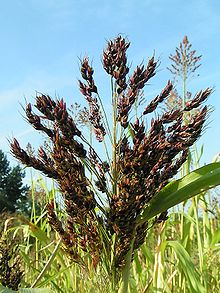| Sorghum | |
|---|---|

| |
| Scientific classification | |
| Kingdom: | Plantae |
| Clade: | Tracheophytes |
| Clade: | Angiosperms |
| Clade: | Monocots |
| Clade: | Commelinids |
| Order: | Poales |
| Family: | Poaceae |
| Subfamily: | Panicoideae |
| Genus: | Sorghum |
| Species: | S. bicolor
|
| Binomial name | |
| Sorghum bicolor | |
| Synonyms[1] | |
|
List
| |
Sorghum bicolor, commonly called sorghum[2] (/ˈsɔːrɡəm/) and also known as great millet,[3] broomcorn,[4] guinea corn,[5] durra,[6] imphee,[7] jowar,[8] or milo,[9] is a species in the grass genus Sorghum cultivated for its grain. The grain is used for food for humans; the plant is used for animal feed and ethanol production. Sorghum originated in Africa, and is now cultivated widely in tropical and subtropical regions.
Sorghum is the world's fifth-most important cereal crop after rice, wheat, maize, and barley.[10] Sorghum is typically an annual, but some cultivars are perennial. It grows in clumps that may reach over 4 metres (13 ft) high. The grain is small, 2 to 4 millimetres (0.08 to 0.2 in) in diameter. Sweet sorghums are cultivars primarily grown for forage, syrup production, and ethanol; they are taller than those grown for grain.
- ^ "Sorghum bicolor (L.) Moench — The Plant List". www.theplantlist.org.
- ^ USDA, NRCS (n.d.). "Sorghum bicolor". The PLANTS Database (plants.usda.gov). Greensboro, North Carolina: National Plant Data Team. Retrieved 2 February 2016.
- ^ BSBI List 2007 (xls). Botanical Society of Britain and Ireland. Archived from the original (xls) on 26 June 2015. Retrieved 14 December 2021.
- ^ "Definition of Broomcorn". www.merriam-webster.com. Retrieved 14 December 2021.
- ^ "Definition of Guinea corn". www.merriam-webster.com. Retrieved 14 December 2021.
- ^ "Definition of Durra". www.merriam-webster.com. Retrieved 14 December 2021.
- ^ "Definition of Imphee". www.merriam-webster.com. Retrieved 14 December 2021.
- ^ "jowar". The Free Dictionary. Retrieved 14 December 2021.
- ^ "Definition of Milo". www.merriam-webster.com. Retrieved 14 December 2021.
- ^ "Major Cereal Grains Production and Use around the World". pubs.acs.org. Retrieved 13 October 2024.